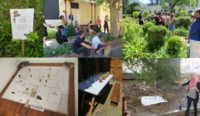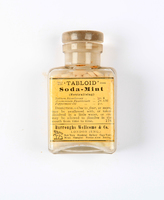Items
Site
The Medicine Chest
keywords is exactly
garden
-

Where the Wild Things Are (Field study)
'Where the Wild Things Are' (21 October – 5 November 2014) explored the political, social and historical narratives embedded in the natural world through investigation, observation, mapping, archival research and art making. The exhibition consisted of various on-site interventions engaging with contemporary and historical spatial dynamics and the significance of Hiddingh Campus. The Egyptian Building (home to sculpture workshops and studios) was built on the site of a zoo established in the late eighteenth century that was replete with lion’s dens and a small lake that supposedly housed a hippo. The campus was also the home to UCT’s first Zoology and Botany building (now the Michaelis Building). This historical perspective highlights both the site’s colonial imprints and its early affiliation with the sciences. The UCT campus is divided into its main upper campus, a middle and lower campus, and a few satellite campuses, of which the Michaelis School of Fine Art and the South African College of Music form part. Students drew on the methodologies of artist/curator Mark Dion, collaborating with specialists from upper campus (entomologists, ornithologists and botanists) and Michaelis Fine Art students, to highlight its natural environment. The interventions occurred on different days, and over a two week period. A calendar was provided to stipulate event times and artwork appearances. Curated by Nina Liebenberg Participating artists: Christopher Swift, Dillon Marsh, Fritha Langerman, Thuli Gamedze, Pippa Skotnes, Alex Kaczmarek, Rone-Mari Botha, Jessica Holdengarde, Fanie Buys, Lara Reusch, Stephani Muller, Tegan Green, Evan Wigdorowitz, Mariam Moosa, C J Chandler, Adrienne Van Eeden-Wharton -

Where the Wild Things Are (Installation detail)
WHERE THE WILD THINGS ARE: An Honours in Curatorship Hiddingh Campus field study Curated by Nina Liebenberg 21 OCTOBER – 5 NOVEMBER 2014 'Where the Wild Things Are' explored the political, social and historical narratives embedded in the natural world through investigation, observation, mapping, archival research and art making. The exhibition consisted of various on-site interventions engaging with contemporary and historical spatial dynamics and the significance of Hiddingh Campus. The Egyptian Building (home to sculpture workshops and studios) was built on the site of a zoo established in the late eighteenth century that was replete with lion’s dens and a small lake that supposedly housed a hippo. The campus was also the home to UCT’s first Zoology and Botany building (now the Michaelis Building). This historical perspective highlights both the site’s colonial imprints and its early affiliation with the sciences. The UCT campus is divided into its main upper campus, a middle and lower campus, and a few satellite campuses, of which the Michaelis School of Fine Art and the South African College of Music form part. Students drew on the methodologies of artist/curator Mark Dion, collaborating with specialists from upper campus (entomologists, ornithologists and botanists) and Michaelis Fine Art students, to highlight its natural environment. The interventions occurred on different days, and over a two week period. A calendar was provided to stipulate event times and artwork appearances. Participating artists: Christopher Swift, Dillon Marsh, Fritha Langerman, Thuli Gamedze, Pippa Skotnes, Alex Kaczmarek, Rone-Mari Botha, Jessica Holdengarde, Fanie Buys, Lara Reusch, Stephani Muller, Tegan Green, Evan Wigdorowitz, Mariam Moosa, C J Chandler, Adrienne Van Eeden-Wharton -

Clivia's in Kirstenbosch
Part of the ‘Useful plants’ section at Kirstenbosch National Botanical Garden. -

Observing marbling in Edirne
A marbling demonstration observed during a 2012 trip to Istanbul and a visit to the neighbouring Edirne's Health Museum. Opened in Sultan Bayezid II külliye in 1488, the hospital treated patients for over 400 years, until 1909, along the tradition of Turkish-Islamic medicine, which included the treatment of diseases by music. -

Pattern recognition
A display in Groote Schuur Hospital, Cape Town. The label reads: The History of Crockery Apartheid did more than separate the races. Parallel with the separate crockery for the different religions (Jewish = Blue; Muslim = Pink) was a range of separate crockery for the staff and patients of different races. Here are a few examples of this complex collection: Royal Blue: Jewish patients and staff (kosher) Dark Navy Blue: "European" patients Green: "European" staff Maroon: "Non European" patients Black: "Non European" staff Pink: Muslim patients and staff (halaal) These pieces of crockery are now part of our history and all patients are served meals in the standard rectangular crocker plate. -

Dis-Location/Re-Location
Farber's research examines themes of adaptation to new surroundings and circumstances through the real-life persona of Bertha Guttmann, a Jewish woman brought to South Africa from Sheffield in 1885 at the age of 22. She entered into an arranged marriage with Sammy Marks, who rose from being a peddler to one of the old Transvaal Republic’s leading industrialists. They lived in a beautiful home, now a museum, called Zwartkoppies, east of Pretoria. "Rather, from the initial cut, she inserts a seedling aloe into her flesh, delicately ‘planting’ the indigenous South African succulent into her forearm. This action represents a physical grafting of an alien botanical life form into the “lily-white corpus of Europe” (Ord 2008:106)" (Farber 2012: 35). Bertha Marks’s construction of the formal English rose garden on the ‘moral wastes’ of the Highveld could be recognised as part of a broader colonial project to ‘civilise’ the ‘barbaric’ African land. The road leading to the eastern gate of Zwartkoppies is lined with Eucalyptus trees planted by Sammy Marks. Rather as in his wife’s attempt to create her formal rose garden in her new surroundings and in so doing to ‘tame’ nature, Sammy Marks embarked on an ambitious campaign to “reclaim” and “green” Zwartkoppies, “creating a civilised landscape out of what his secretary called a wilderness” (Mendelsohn 1991:104). Thousands of trees were planted, mainly exotic varieties such as pines and blue gums, as well as orchards and vineyards (Mendelsohn 1991:104)" (Farber 2012: 58) -

Soda-Mint
"However, this bottle was not marked ‘poison,’ so Alice ventured to taste it, and, finding it very nice (it had, in fact, a sort of mixed flavour of cherry-tart, custard, pineapple, roast turkey, toffy, and hot buttered toast), she very soon finished it off. ‘What a curious feeling!’ said Alice. ‘I must be shutting up like a telescope!’ And so it was indeed: she was now only ten inches high, and her face brightened up at the thought that she was now the right size for going through the little door into that lovely garden. First, however, she waited for a few minutes to see if she was going to shrink any further: she felt a little nervous about this; ‘for it might end, you know,’ said Alice to herself, ‘in my going out altogether, like a candle. I wonder what I should be like then?’" (Carroll 2007: 18).


